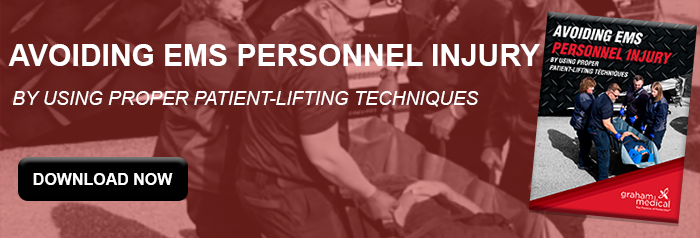 The transport of patients through tight places is always difficult. Patients need to be kept safe and EMS personnel need to avoid excessive body strain that may cause injury. This is exacerbated with large or bariatric patients, something that's becoming more common. According to the Institute for Health Metrics and Evaluation, "Nearly three-quarters of American men and more than 60% of women are obese or overweight." That creates a real issue when having to extract the person from a tight space.
The transport of patients through tight places is always difficult. Patients need to be kept safe and EMS personnel need to avoid excessive body strain that may cause injury. This is exacerbated with large or bariatric patients, something that's becoming more common. According to the Institute for Health Metrics and Evaluation, "Nearly three-quarters of American men and more than 60% of women are obese or overweight." That creates a real issue when having to extract the person from a tight space.
A tight space, when applied to moving patients, can mean older buildings with narrow passageways and tight stairways, small areas like crowded bathrooms or even culverts and caves. It's equally valid when rescuing patients in hilly, rough and broken terrain. In many such instances, conventional rigid stretchers are almost useless.
Injury Risks
Apart from the need to carry patients so they are relatively comfortable and avoid aggravating their injuries, there's a crucial need to protect EMS staff. According to EMS World, almost 25 percent of EMS workers suffer serious back injuries in the first four years of their careers. This isn't surprising considering that the recommended maximum lifting load is only 51 pounds and goes down to 35 pounds when lifting a patient - under ideal conditions.
According to this 2017 CDC Faststats, the average weight for an adult male is 195.7 lbs., while that for an average female adult is 168.7 lbs. In either case, this means that at least a four person team is necessary for safe and efficient transport when the conditions are ideal.
When extracting heavy patients from a tight space or transporting them down a narrow hall or stairway, the conditions become less than ideal and should be done by six persons or more.
How a Flexible Stretcher Protects Patients
The primary difficulty with rigid stretchers in tight places is an inability to maneuver them around corners and over obstacles. Often stretchers or backboards have to be tipped at an awkward angle or raised into a partially vertical position. This is uncomfortable and potentially dangerous for all involved.
These constraints don't apply to flexible stretchers because:
- They wrap around the patient
- Space needed is limited only by the patient's size
- EMS workers can use the natural flexibility of the body, without harming the patient
- Flexible support provided is considered safer than immobilizing patients on rigid backboards
Protection of EMS Personnel in Tight Spaces
Apart from the advantages for the patient, flexible stretchers are easier on EMS personnel and lead to fewer injuries. Here's how:
- Multiple handholds: Flexible stretchers have numerous strong handholds on either side. Apart from providing a secure grip, they allow EMS personnel to use both hands, reducing their body loading. The multiple handholds make it possible for several personnel to share the load and ease patients through tight spaces.
- Pull straps: Fitted to both ends, pull straps facilitate the lowering of patients down slopes and stairs as well as allowing EMS to safely drag patients over the ground.
- Strength and tear resistance: Flexible stretchers made from tough, non-woven material, are tear-resistant and don't snag easily. Many support loads of up to 1,000 pounds.
- Flexibility: Their flexibility and wraparound ability makes it easy to hold patients even when descending stairs.
For patient transport in tight spaces, Graham Medical's MegaMover® ticks all the right boxes. Contact us to find out more about MegaMover® transport units.

